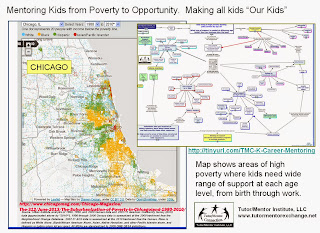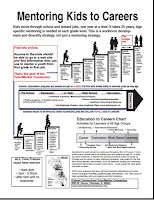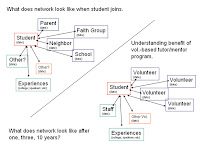Over the past 40 years of leading a tutor/mentor program in Chicago, I've come to think of volunteer based tutor/mentor programs as an ideal structure to help connect youth from high poverty areas with volunteers from a wide range of backgrounds beyond poverty. This image is one that illustrates this diversity.
In the past ten to 15 years I've come to understand this as a form of social capital, greatly influenced by Robert Putnam and others. Thus, I was pleased to learn of his new book, titled “Our Kids: The American Dream in Crisis”. I picked up a copy last week and have read about 30%. Yesterday I shared a link to this New York Times book review with a college fraternity brother who lives in Bend, Oregon, which was profiled in the book. Today he sent me this article from his local newspaper, which has an extensive analysis of the book, and the problems it points out to communities all over the country.
I created the graphic below by combining a map showing poverty in the Chicago region with a concept map showing supports kids need as they move from first grade through school and into a post college or vocational school job and career.
The map can be seen here. The concept map can be seen here.
In the 1990s when I was first launching the Cabrini Connections tutor/mentor program, I coined the term "Total Quality Mentoring (TQM) to communicate the idea of site based tutor/mentor programs supported by volunteers from many different backgrounds, who were constantly learning from a network of peers, and constantly innovating ways to expand the support they were offering to youth.
The hub of the wheel represents a single child, or a group of kids. The spokes lead to the different careers kids might aspire to. In the Birth to Work chart at the left, you can see that there are a variety of age-appropriate activities that could be introduced to a youth, through school, or non-school programs.
It only takes motivation, talent, resources and some stimulation to recognize ideas that you might not otherwise be aware of.
The concept map above is just a different version of these, and illustrates how I've continuously looked for better ways to communicate this idea. You can see a map of Chicago is embedded in the TQM chart, and in many of my blog articles, illustrating the need for well organized programs in every poverty neighborhood. Since the early 1990s I've been using maps to show the gap between rich and poor, and graphics to show how well organized, volunteer-based tutor/mentor programs could offer the mentoring, tutoring, and other supports that rich kids take for granted.
The TQM idea never caught on, but I've continued to share the idea through printed newsletters, up till 2002, and email newsletters, blogs and web sites since 1998.
When I talk about "constantly improving" I mean that people in different programs, as well as resource providers, are digging into a library of information that shows what other people are doing in different places, that could be duplicated in many other places, if the motivation, talent and financial resources were available. Below is a graphic showing the four categories of information I've been aggregating.
One section of the library points to articles about social capital and ideas of how to map the networks youth and volunteers have when they join a program, and how that changes over time as a result of on going participation and consistent support by donors.
I hope the work Robert Putnam and others are doing to make this a focus of the 2016 national election will motivate more people to want to dig into the information and articles I've been writing for many years. Just wanting to make support systems available is not the same as building and sustaining age appropriate programs in cities and neighborhoods all across the country.
Just one last graphic. View this video to see how volunteer who become involved in TQM programs can grow to be leaders who get other people involved. If this idea is embraced in communities and neighborhoods throughout the country, we have a strategy for engaging a growing number of people from both sides of a community in efforts that close the gaps that Putnam and others fear is irrevocably dividing America.
I look forward to being part of the planning, brainstorming and innovations of others who are focused on this same issue.
Monday, March 16, 2015
Subscribe to:
Post Comments (Atom)















No comments:
Post a Comment